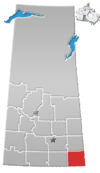Rural municipality in Saskatchewan, Canada
| Estevan No. 5 | |
|---|---|
| Rural municipality | |
| Rural Municipality of Estevan No. 5 | |
 | |
 | |
 Location of the RM of Estevan No. 5 in Saskatchewan Location of the RM of Estevan No. 5 in Saskatchewan | |
| Coordinates: 49°07′55″N 102°58′34″W / 49.132°N 102.976°W / 49.132; -102.976 | |
| Country | Canada |
| Province | Saskatchewan |
| Census division | 1 |
| SARM division | 1 |
| Federal riding | Souris—Moose Mountain |
| Provincial riding | Estevan |
| Formed | December 12, 1910 |
| Government | |
| • Reeve | Terry Keating |
| • Governing body | RM of Estevan No. 5 Council |
| • Administrator | Loran Tessier |
| • Office location | Estevan |
| Area | |
| • Land | 772 km (298 sq mi) |
| Population | |
| • Total | 1,279 |
| • Density | 1.7/km (4/sq mi) |
| Time zone | CST |
| • Summer (DST) | CST |
| Postal code | S4A 0T8 |
| Area code(s) | 306 and 639 |
| Website | rmestevan |
The Rural Municipality of Estevan No. 5 (2016 population: 1,370) is a rural municipality (RM) in the Canadian province of Saskatchewan within Census Division No. 1 and SARM Division No. 1. Located in the southeast portion of the province, it surrounds the City of Estevan. The RM is adjacent to the United States border, neighbouring Divide County and Burke County in North Dakota.
History
The RM of Estevan No. 5 incorporated as a rural municipality on December 12, 1910.
Geography
Communities and localities
The following urban municipalities are surrounded by the RM.
Parks and recreation
The following parks are within the RM:
Demographics
| Year | Pop. | ±% |
|---|---|---|
| 1981 | 1,185 | — |
| 1986 | 1,270 | +7.2% |
| 1991 | 1,139 | −10.3% |
| 1996 | 1,078 | −5.4% |
| 2001 | 1,055 | −2.1% |
| 2006 | 1,051 | −0.4% |
| 2011 | 1,139 | +8.4% |
| 2016 | 1,370 | +20.3% |
| 2021 | 1,279 | −6.6% |
| Source: Statistics Canada via Saskatchewan Bureau of Statistics | ||
In the 2021 Census of Population conducted by Statistics Canada, the RM of Estevan No. 5 had a population of 1,279 living in 474 of its 527 total private dwellings, a change of -6.6% from its 2016 population of 1,370. With a land area of 772 km (298 sq mi), it had a population density of 1.7/km (4.3/sq mi) in 2021.
In the 2016 Census of Population, the RM of Estevan No. 5 recorded a population of 1,370 living in 487 of its 525 total private dwellings, a 20.3% change from its 2011 population of 1,139. With a land area of 773.38 km (298.60 sq mi), it had a population density of 1.8/km (4.6/sq mi) in 2016.
Government
The RM of Estevan No. 5 is governed by an elected municipal council and an appointed administrator that meets on the second and fourth Wednesday of every month. The reeve of the RM is Terry Keating, while its administrator is Loran Tessier. The RM's office is located in Minton.
See also
References
- "Pre-packaged CSV files - CGN, Canada/Province/Territory (cgn_sk_csv_eng.zip)". Government of Canada. July 24, 2019. Retrieved May 23, 2020.
- ^ "Rural Municipality Incorporations (Alphabetical)". Saskatchewan Ministry of Municipal Affairs. Archived from the original on April 21, 2011. Retrieved May 9, 2020.
- ^ "Municipality Details: RM of Estevan No. 5". Government of Saskatchewan. Retrieved May 21, 2020.
- ^ "Population and dwelling counts: Canada, provinces and territories, census divisions and census subdivisions (municipalities), Saskatchewan". Statistics Canada. February 9, 2022. Retrieved April 13, 2022.
- "Saskatchewan Census Population" (PDF). Saskatchewan Bureau of Statistics. Archived from the original (PDF) on September 24, 2015. Retrieved May 9, 2020.
- "Saskatchewan Census Population". Saskatchewan Bureau of Statistics. Retrieved May 9, 2020.
- "Population and dwelling counts, for Canada, provinces and territories, and census subdivisions (municipalities), 2016 and 2011 censuses – 100% data (Saskatchewan)". Statistics Canada. February 8, 2017. Retrieved May 1, 2020.
External links
| Places adjacent to Rural Municipality of Estevan No. 5 | |
|---|---|
| Division No. 1, Saskatchewan | |||||
|---|---|---|---|---|---|
| Cities |  | ||||
| Towns | |||||
| Villages | |||||
| Rural municipalities | |||||
| First Nations | |||||
| Indian reserves | |||||
| Unincorporated communities |
| ||||
|
| |||||